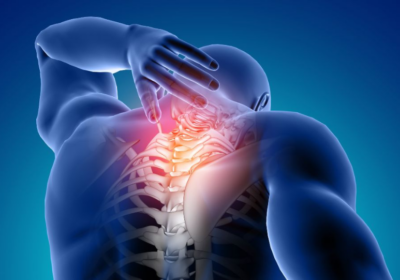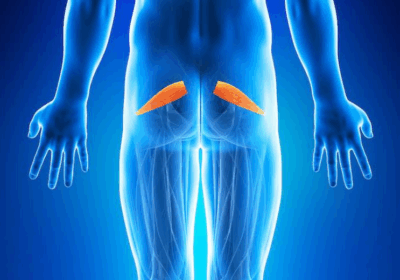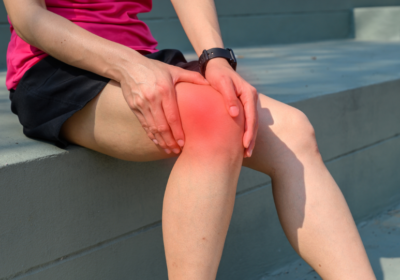HEALING CERVICAL SPONDYLOSIS THROUGH AYURVEDA

Cervical Spondylosis is a degenerative condition affecting the cervical spine, commonly seen in middle aged and older adults. Its characterized by age related wear and tear of the intervertebral discs, vertebrae and associated structures, leading to functional changes in the cervical spine.
In Ayurveda cervical spondylosis is considered under vata vyadhi( where vata is responsible for the movement, nerve function circulation). Vata lodges in Asthi dhathu(bone tissue) and leading to the degeneration of bones and cartilage in the cervical region. Along with that due to toxins(ama)accumulation which causes stiffness, pain and restricted movements.
PATHOPHYSIOLOGY:
- Degenerative changes in the cervical spine, intervertebral discs, vertebrae and facet joints: Gradual loss of hydration and elasticity in the discs leads to reduced shock absorption and disc height.
- Development of bone spurs(osteophytes):Bone spurs develops as a compensatory response to increased stress on the vertebrae.
- Due to disc herniation and ligament thickening nerve compression occurs.
- Spinal nerve impingement seen in advanced cases either by narrowing of spinal canal(spinal stenosis) or foramina stenosis.
CLINICAL SYMPTOMS
Cervical spondylosis can cause a wide range of clinical symptoms ,which often vary depending on the severity of the degenerative changes and specific nerves or spinal structure affected. The most common symptoms include:
1.Neck Pain and stiffness:
- Stiffness usually seen in morning or after a long period of inactivity.
- Pain worsen with certain neck movements such as bending or extending the neck.
2.Headaches:
- Usually cervicogenic headaches.
- Pain radiates from the neck to the back of the head and temples.
3.Radicular symptoms(Nerve Compression).
- Radiating Pain from neck to hands.
- Numbness and tingling in arms, hands or fingers.
- Muscle weakness makes it difficult to grab objects or perform fine tasks.
4.Myelopathy(Spinal cord compression)
Spinal Cord Compression leads to,
- Difficulty with coordination.
- Weakness in arms or legs.
- Loss of fine motor skills
- Bowel or bladder dysfunction.
5.Reduced range of motion:
- Limited ability to move the neck freely leading to stiffness.
- Difficulty turning the head or looking over the shoulder.
6.Grinding or popping sensations:
- A feeling of grinding or popping in the neck with movement, AKA crepitus caused by changes in joints and discs.
7.Dizziness or vertigo
- Occasional dizziness or a sensation of spinning, especially when moving the neck quickly.
8.Fatigue and sleep disturbances:
- Chronic neck pain can lead to poor sleep quality and fatigue over the time.
9.Shoulder pain:
- Pain that radiates from the neck into the shoulder blades of upper back, sometimes mimicking shoulder joint issues.
DIAGNOSIS OF CERVICAL SPONDYLOSIS
Here are the diagnostic techniques used in cervical spondylosis:
1.MEDICAL HISTORY:
- Symptom assessment: Which includes duration, intensity of neck pain, stiffness headaches and neurological symptoms.
- Medical and family history: Any history of injuries, previous spinal issues or family history of degenerative spine conditions is noted.
- Lifestyle factors: Information about occupation ,activities and ergonomics that may contribute to neck strain.
2.PHYSICAL EXAMINATION:
- Neurological Examination: Assessment of reflexes, muscles strength and sensory function to determine if there is any nerve compression.
- Range of motion testing: To assess stiffness or pain.
- Palpation: For checking tenderness, muscle tightness and abnormalities in the cervical spine.
3.IMAGING STUDIES:
- X-rays
- MRI
- CT-Scan
- Electrodiagnostic Tests
-Nerve Conduction Studies(NCS)
-Electromyography(EMG)
4.ADDITIONAL TESTS:
- Blood Tests: To rule out other conditions such as inflammatory diseases or infections that might mimic cervical spondylosis symptoms.
- Functional Tests: Evaluating the patient’s ability to perform daily activities and how cervical spondylosis affects their quality of life.
TREATMENT OF CERVICAL SPONDYLOSIS IN MAURYA AYURVEDA
Our hospital have an integrated approach in managing cervical spondylosis, by collaborating Ayurveda, Acupuncture and Physiotherapy. The treatment modalities followed in our hospital are:
EXTERNAL TREATMENTS PROVIDED IN OUR HOSPITAL:
1.PODI KIZHI:
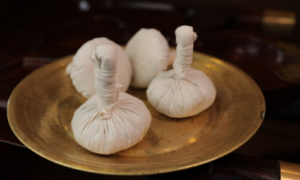
In podi kizhi, herbal powders are tied in a cloth bundle (kizhi) and applied to the body by heating it. In our hospital we normally use Kolakulathadi chooram for preparing the podi kizhi. It’s otherwise also called as rooksha kizhi or choorna pinda sweda.
Benefits of podi kizhi:
- Relieves pain and stiffness.
- Reduces inflammation.
- Improves circulation.
- Strengthens muscles and nerves.
2.NADI SWEDAM:
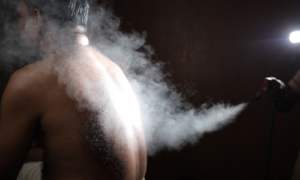
Nadi Swedam is a procedure that involves localized steam application to specific body parts using medicinal herbal decoction Usually we use dashamoola kashayam to produce medicinal steam.
Benefits of Nadi swedam:
- Reduces inflammation.
- Alleviates stiffness and muscle tension.
- Rejuvenate the joints and muscles.
- Enhanced flexibility and mobility of joints.
3.ELAKIZHI:
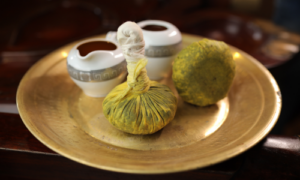
Ela kizhi is also known as Patra pinda Sweda is an ayurvedic treatment that involves the use of herbal poultices made from medicinal leaves, which are dipped in warm medicinal oil and massaged over the body. Elakizhi is typically made from castor leaves (Eranda, Ricinus communis), tamarind leaves (Tamarindus indica), arka leaves (Calotropis gigantea)etc.
Benefits of Ela kizhi:
- Pain relief.
- Reduces inflammation.
- Relieves muscle stiffness and spasms.
- Improved blood circulation.
- Lubricates the joints
- Flexibility and mobility increased.
4.LEPAM:
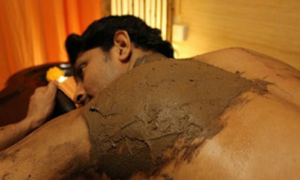
In Ayurveda, lepam is the term for the application of a medicinal herbal paste that is left on the body for about 30 to 60 minutes. The paste can be removed by washing it off once it dries. When using lepam, we typically employ RASNADI and GRAHADHOOMADI choornam. The rasnadi choornam is mixed with lemon juice and warmed and used as lepam. Wherein grahadhoomadi is mixed either with lemon juice or dhanyamla ,heated and is used as lepam.
Benefits of LEPAM:
- Reducing inflammation and oedema.
- Aids in easing stiffness and discomfort in the muscles.
- Lessens joint pain as well.
5.GREEVA VASTHI :
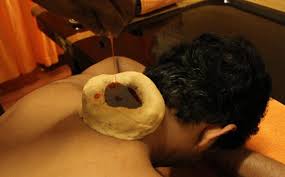
Greeva Vasthi is the retention of warm medicated oil over the cervical spine for a specific duration(20-40 minutes), by creating a dam-like structure using black gram or wheat flour dough. Commonly used oils are Ksheerabala taila, Dhanwataram taila etc for retention.
Benefits of Greeva Vasthi:
- Reduction in pain.
- Reduction in inflammation.
- Relieves stiffness and muscle spasms.
- Nourishes and lubricates the joints.
- Strengthens cervical spine.
6.NASYAM:
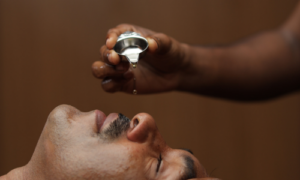
Nasyam is an important ayurvedic therapy that involves administering medicated oils through the nostrils.Normally there are two kinds of nasaya.
- Pratimarsha nasya:where we administer medicated oil in minimum dosage(2 drops).Normally we use anutaila for the same.Also done for about 3 days.
- Marsha nasyamm: Here we administer medicated oil is administered in maximum dosage(begining from 2 drops to max 10 drops).Normally we use ksheerbala (101) for this type.
Benefits of Nasyam:
- Relieves neck pain and stiffness.
- Reduces inflammation.
- Improves nervous system function.
- Promotes detoxification.
- Reduces tension and headaches.
- Improves mobility of neck.
- Prevents degeneration.
- Calms the mind and reduces stress.
7.DHARA:
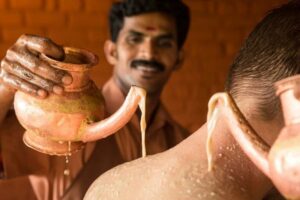
A constant stream of medicinal liquids such as buttermilk, milk, medicinal oil or decoctions, is applied to the afflicted area during the therapeutic process is known as dhara. Dhara is categorized according to the liquid used and the location. In these circumstances, we typically do kashaya dhara and dhanyamla dhara.
- DHANYAMLA DHARA: This type of specialized therapy involves dhanyamla (fermented medicinal liquid), being poured over the body in a steady stream.
Advantages of DHARA
- It helps to lessen inflammation.
- It eases pain.
- It aids in the process of detoxification.
- It causes nerves to be stimulated.
ROLE OF PHYSIOTHERAPY IN CERVICAL SPONDYLOSIS
Physiotherapy got a major role in managing cervical spondylosis. Here are few techniques and benefits associated with it:
Manual Therapy:
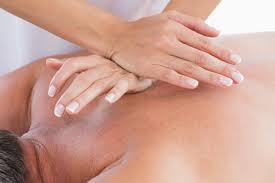
Physiotherapists can diagnose and treat patients with precise hand movements by using manual therapy.
Major goals of physiotherapy:
- Enhancing tissue extensibility.
- Expanding range of motion.
- Promoting relaxation.
- Mobilizing or manipulating soft tissue and joints.
- Adjusting the muscle function.
- Managing the discomfort.
- Enhancing movement patterns.
- Lowering soft tissue edema inflammation, or limitation.
Cryotherapy(Cold therapy) :
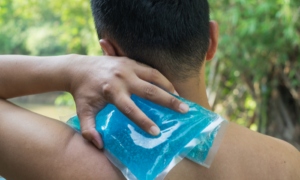
During cold application, blood flow to the affected area is reduced, which helps in reduction of swelling, inflammation and numbs the affected area for pain reduction .It’s much more beneficial in the acute phase of cervical spondylosis. Cold gel packs, cold compression therapy or ice packs are generally used for it.
Thermotherapy(Heat Therapy):
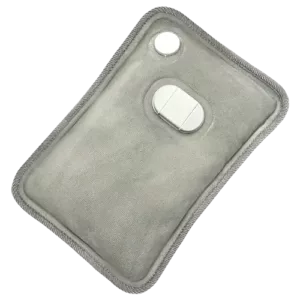
Heat can accelerate the blood flow to the impacted region, oxygen and nutrients are also brought to that area and promotes the healing. Normally hot packs, infrared lamps, heating pads, warm baths etc are used for this. It helps to relieve muscle stiffness, chronic pain, improves flexibility of joints and muscles. It’s much more beneficial in the chronic stage of cervical spondylosis.
Combination Therapy:
The therapists normally, alternatively use heat and cold therapy to get relieved with symptoms effectively. Eg: Heat therapy is used to improve the range of motion and helps in muscle relaxation wherein cold therapy reduces inflammation.
Neck Isometrics:
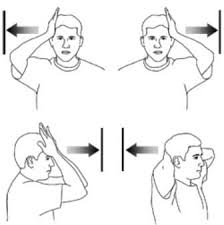
Contracting your neck muscles without moving your head is known as neck isometrics. These exercises assist in reducing tension, strengthening the neck muscles and enhancing stability. Some neck isometric exercises for cervical spondylosis are:
- Neck flexion(Front)Isometric.
- Neck Extension(Back)Isometric.
- Side Flexion(Right and left).
- Neck Rotation Isometric.
Each exercise should be repeated 5-10 times and (5-10)seconds hold is also needed.
Range of Motion Exercise:

Exercises coming under ROM are:
- Neck Flexion(Forward Bending)
- Neck Extension(Backward bending)
- Lateral Neck flexion.
- Neck rotation(turning).
- Neck circumduction(with caution).
This exercise helps to reduce stiffness and improve flexibility.
Cervical Traction:

In order to treat disorders like cervical spondylosis, cervical traction is a therapeutic treatment that relieves strain over the cervical spine. It releases pressure on the nerves, increases space between the vertebrae and relieves symptoms including pain, stiffness and tingling, as it entails carefully repositioning the head relative to the neck.
- Types of Cervical Traction:
- Manual Cervical Traction.
- Mechanical Cervical Traction.
- People with severe osteoporosis, infections, spinal instability or fractures etc should not use cervical traction.
Benefits of cervical Traction:
- Helps in pain management.
- Mobility Improved.
- Disc decompression.
- Improves the alignment of the spine.
Neck Strengthening Exercises:
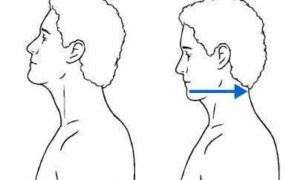
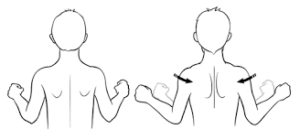
Few frequently suggested neck strengthening exercises are:
- Chin Tucks
- Shoulder blade squeeze.
- Neck retractions with resistance band.
- Prone cobra.
- Isometric Neck flexion, extension, side flexion and neck rotation.
- Exercises that strengthen the neck are crucial for treating cervical spondylosis because they assist to stabilize the cervical spine, enhance posture and lessens the pain. By putting the less strain on the discs and vertebrae, strengthening the neck muscles helps lessen stiffness,neck pain and headache.
Neck Stabilization Exercises:
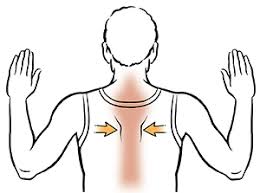
- The purpose of neck stabilization exercises is to increase the deep neck muscles’ strength and endurance, which support and stabilize the cervical spine. These given below exercises for the neck stabilization are quite helpful.
- Head Lifts(Supine).
- Quadruped Head and Neck Control(Bird Dog)
- Standing Wall Plank.
- Neck Bracing with Shoulder Shrugs.
- Isometric Neck Stabilization(All Directions).
- Shoulder Blade squeeze.
- Thera band or resistance Band Exercises.
- Regular performance of these exercises can help lessen the symptoms related to cervical spondylosis, increase the stability and strengthen the neck.
Modalities:
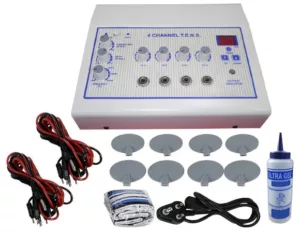
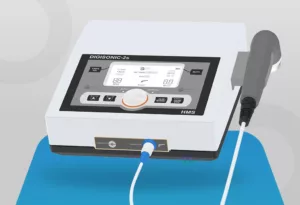
TENS :
- It blocks pain signals from reaching the brain by applying modest electrical impulses to nerves through electrodes applied to the skin. This process may also encourage the release of endorphins, the body’s natural analgesics.
Advantages of application of TENS:
- Lessens pain in the shoulders and neck.
- Relieves muscle tension and spasms.
- Expanded range of motion.
- Decrease in neuropathic pain.
- The quality of sleep will be improved.
Ultrasound:
- It’s a widely used modality in physiotherapy ,employing high frequency sound waves to treat various musculoskeletal conditions. Various techniques of ultrasound are: Continuous ultrasound, pulsed ultrasound, phonophoresis, Low intensity pulsed ultrasound(LIPUS).
Benefits of Ultrasound in cervical spondylosis are:
- Accelerates pain relief.
- Aids is scar tissue breakdown and tissue healing.
- Improves blood circulation.
- Reduction of inflammation and edema.
ROLE OF ACUPUNCTURE IN CERVICAL SPONDYLOSIS
The main techniques of acupuncture used in our center are:
1.Insertion of needle:
- Common acupoints include GB20(Fengchi),BL10(Tianzhu),L14(Hegu) and S13(Houxi) etc, where these point are located in the base of skull, neck and hand.
- This extremely beneficial in reduction of stiffness, pain and tension in the cervical region.
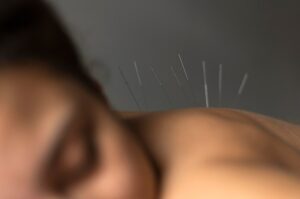
2.Electro acupuncture:
- Here mild current is attached to the needles that are inserted.
- It mainly aids in alleviation of tingling and numbness by a gentle stimulation.
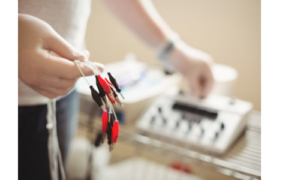
3.Acupressure:
- Here gentle pressure is applied on acupoints, round the cervical and shoulder region.
- It helps in relieving in pain, discomfort etc associated with cervical spondylosis.
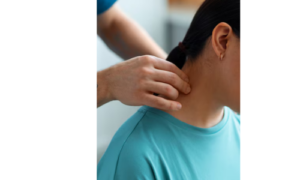
DIETARY GUIDELINES FOLLOWED IN OUR HOSPITAL
GENERAL INSTRUCTION SUGGESTED :
- Avoid vigorous activities.
- Drink 2.5–3 liters of water.
FOOD ITEMS RECOMMENDED ARE:
- Steamed food items like idiyappam, put, chapati, Appam(not fermented).
- Vegetable in boiled form.
- Hot kanji.
FOOD ITEMS DISCOURAGED ARE:
- Fermented foods like dosa, idli, fermented appam.
- Tuber items like potato, tapioca and sweet potato.
- Non vegetarian items like fish, egg and meat(can be taken in curry form, if necessary).
- Milk, milk products, cold food, pickles, fruits, dry fruits, nuts, fast food, fried and oily foods.
DISCLAIMER: The information provided in this article is intended solely for educational purposes. Treatment decisions should be made exclusively by a well-qualified Ayurvedic physician. Self-medication is strongly discouraged.


